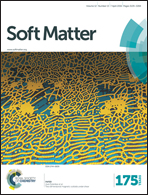Substrate temperature controls molecular orientation in two-component vapor-deposited glasses
Abstract
Vapor-deposited glasses can be anisotropic and molecular orientation is important for organic electronics applications. In organic light emitting diodes (OLEDs), for example, the orientation of dye molecules in two-component emitting layers significantly influences emission efficiency. Here we investigate how substrate temperature during vapor deposition influences the orientation of dye molecules in a model two-component system. We determine the average orientation of a linear blue light emitter 1,4-di-[4-(N,N-diphenyl)amino]styryl-benzene (DSA-Ph) in mixtures with aluminum-tris(8-hydroxyquinoline) (Alq3) by spectroscopic ellipsometry and IR dichroism. We find that molecular orientation is controlled by the ratio of the substrate temperature during deposition and the glass transition temperature of the mixture. These findings extend recent results for single component vapor-deposited glasses and suggest that, during vapor deposition, surface mobility allows partial equilibration towards orientations preferred at the free surface of the equilibrium liquid.


 Please wait while we load your content...
Please wait while we load your content...